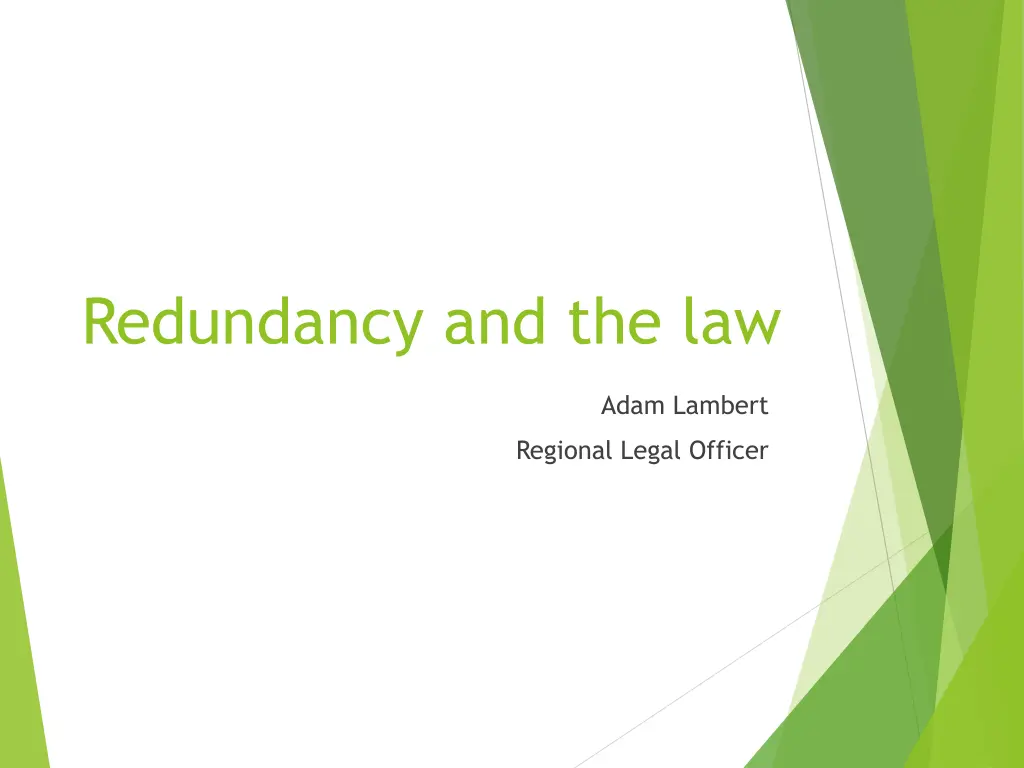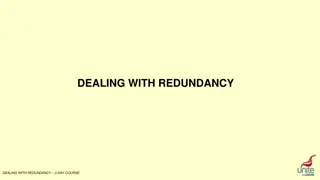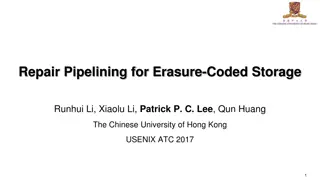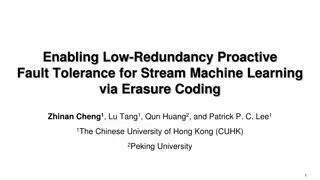
Redundancy and the Law: Understanding Your Rights in the Workplace
Learn about the legal aspects of redundancy in the workplace, including how to determine if a redundancy is genuine, the consultation process, fair selection criteria, alternative employment options, notice and payment obligations. Explore the criteria for genuine redundancy and how tribunals assess employer decisions. Understand collective consultation requirements under section 188 TULRCA for dismissing multiple employees.
Download Presentation

Please find below an Image/Link to download the presentation.
The content on the website is provided AS IS for your information and personal use only. It may not be sold, licensed, or shared on other websites without obtaining consent from the author. If you encounter any issues during the download, it is possible that the publisher has removed the file from their server.
You are allowed to download the files provided on this website for personal or commercial use, subject to the condition that they are used lawfully. All files are the property of their respective owners.
The content on the website is provided AS IS for your information and personal use only. It may not be sold, licensed, or shared on other websites without obtaining consent from the author.
E N D
Presentation Transcript
Redundancy and the law Adam Lambert Regional Legal Officer
Redundancy: where the law protects Is the redundancy genuine? Has there been adequate consultation? Is the selection pool and process fair? Has suitable alternative employment been offered? Has the employee received the proper notice and redundancy payment?
Is there a genuine redundancy? 139. (ERA 96) Redundancy. (1) For the purposes of this Act an employee who is dismissed shall be taken to be dismissed by reason of redundancy if the dismissal is wholly or mainly attributable to (a) the fact that his employer has ceased or intends to cease (i) to carry on the business for the purposes of which the employee was employed by him, or (ii) to carry on that business in the place where the employee was so employed, or (b) the fact that the requirements of that business (i) for employees to carry out work of a particular kind, or (ii) for employees to carry out work of a particular kind in the place where the employee was employed by the employer, have ceased or diminished or are expected to cease or diminish. Basically: does the employer still need as many, or any, employees to continue to do the work currently undertaken by the employee? Redundancy concerns the role, not the individual.
A tribunal will not look beyond the legislation regarding the reasonableness of the employer s decision to restructure. Closure of the workplace includes relocation and temporary closure. Mobility clauses can be heavily relied upon by an employer, i.e. relocation can constitute a reasonable management instruction rather than a redundancy situation Diminishing requirement for employees to carry out work of a particular kind includes reallocation of duties/restructuring.
Collective consultation: section 188 TULRCA Where an employer is proposing to dismiss as redundant 20 or more employees at one establishment within a period of 90 days or less the employer shall consult about the dismissal all the persons who are the appropriate reps of any of the employees who may be affected In good time and always 45 days where 100 or more redundancies 30 days where 20 or more redundancies before the first dismissal takes effect. Includes dismissals as a result of substantial changes to terms and conditions (Some Other Substantial Reason/ SOSR dismissals)
Purpose of Collective Consultation Avoiding dismissals Reducing the number of dismissals Mitigating the consequences of dismissals with a view to reaching agreement - A failure to consult gives rise to a Protective Award claim worth up to 13 weeks pay.
Information to be provided Reasons for the redundancies Number and description of employees Total number of employees Proposed method of selection Proposed method of carrying out the dismissals Proposed method of calculating redundancy pay Number of agency workers and the type of work they do/where they work HR1 form All above should be given to representatives or sent to union s head office if sent by post.
Problems with consultation during the pandemic Full and future effects of pandemic unknown Where reps and members away from work, need access to all of bargaining unit Members may not have internet access Employer facilities (e.g. zooms) must be confidential It is expected that tribunals will take a view that consultation is lawful where an employer has made suitable adjustments for the current circumstances.
Avoiding/mitigating redundancies Coronavirus Job Retention Scheme to run until end of September 2021 Temporary contractual changes Voluntary redundancy Voluntary early retirement Recruitment freezes Overtime bans Ending the use of temp/agency staff and secondments Reduction in hours/job share Re-engagement agreements
The selection pool Should be discussed with the union Account should be taken of similarity and interchangeability of work, plus previous work undertaken by employees. Employer need only apply their minds Case law favours wider selection pools: risk averse employers have more to fear from excluding employees than including them
Selection criteria Should be objective and fairly applied, or not wholly subjective e.g. Howard v Siemens Energy Services Ltd adherence to values Cannot challenge scores unless clearly unreasonable, nor is there a right to see other individual employee s scores Important the redundancy policy/procedure is followed.
Discrimination Sickness absence Flexibility Length of service Cost e.g. redundancy/pensions (Seldon v Clarkson Wright & Jakes [2012]: cost on its own not a legitimate criteria) Duty to make reasonable adjustments where an employee is disabled Enhanced right of women on maternity leave Part-time/fixed-term employees Remember time limits!
Suitable alternative employment Obligation arises at point a decision is made to delete roles; not at point of selection. Whether a role is SAE is objective and based on the role: Job content Status T&Cs Whether can decline a role and have the right to a redundancy payment is subjective and based on the individual employee s circumstances, e.g. domestic situation, commuting arrangements. Right to reasonable paid time off to seek alternative work. Can employer offer retraining, careers advice, paid travel to interviews?
Trial periods Statutory period of 4 weeks unless difference in role is trivial Statutory period can be extended with employer/employee agreement for training purposes only A failure to offer a trial period is likely to make redundancy unfair Whether suitable is determined by the employer and then open to challenge in tribunal aim for a collectively negotiated approach
Redundancy pay/notice Statutory redundancy pay: 2 years service required Depends on age: (half a week/year worked below 22 yrs, one week/yr aged 22-40, week and half/yr aged over 40yrs) Cap of 544/week Cap of 20 years Tax-free up to 30K Statutory notice: 1 week/year of service up to 12 weeks (minimum 1 week for 1 month s service) Contract may give enhanced entitlements in respect of redundancy and notice
Legal remedies ET Limitation of 3 months less 1 day: Unfair dismissal (requires two years service) Breach of contract inc. Unlawful Deduction of Wages Protective award Limitation of 6 months from dismissal: Statutory redundancy claim Criminal Failure to provide a redundancy statement showing the redundancy payment that has been made






















